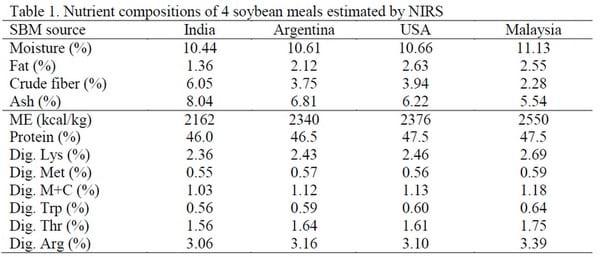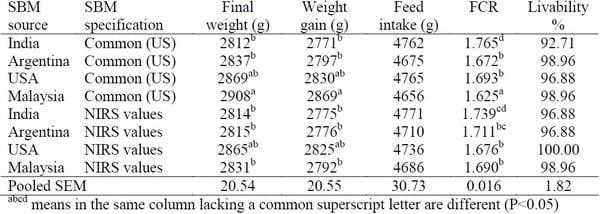Digestible Amino Acids and AME of Soybean Meals
Using NIRS and Broilers Performance Tests to Assess Digestible Amino Acids and AME of Soybean Meals
Published: August 24, 2011
By: Y. G. Liu and Z. Y. Zhu (Adisseo)
ABSTRACT
Nutritive values of major ingredients vary considerably not only among different feedstuff but also the same ingredients of different batches. Rapid screening nutritive value has been a great challenge in the feed industry. This study assessed 4 soybean meal (SBM) samples using both NIRS technique and broiler experiments. In broiler Test 1, 4 SBM samples were assigned the same "book value", so that the four dietary formulations were identical except different sources of SBM; In broiler Test 2, individual NIRS data were used for formulation so SBM inclusion levels varied in order to reach iso-energy and iso-nitrogenous. Total 8 treatment x 6 replication x 16 male birds, from day 1 to 40 days of age. The results showed that when using the common values for the 4 SBM, broiler grew differently in live weight and feed conversion (P<0.05) whilst formulating based on individual NIR values the birds grew similarly. The results demonstrate that the values of SBM vary considerably and largely defined by their levels of ME and digestible amino acids rather than crude protein level, and that the NIRS estimates for AME and DAA appear to be largely correct.
Nutritive values of major ingredients vary considerably not only among different feedstuff but also the same ingredients of different batches. Rapid screening nutritive value has been a great challenge in the feed industry. This study assessed 4 soybean meal (SBM) samples using both NIRS technique and broiler experiments. In broiler Test 1, 4 SBM samples were assigned the same "book value", so that the four dietary formulations were identical except different sources of SBM; In broiler Test 2, individual NIRS data were used for formulation so SBM inclusion levels varied in order to reach iso-energy and iso-nitrogenous. Total 8 treatment x 6 replication x 16 male birds, from day 1 to 40 days of age. The results showed that when using the common values for the 4 SBM, broiler grew differently in live weight and feed conversion (P<0.05) whilst formulating based on individual NIR values the birds grew similarly. The results demonstrate that the values of SBM vary considerably and largely defined by their levels of ME and digestible amino acids rather than crude protein level, and that the NIRS estimates for AME and DAA appear to be largely correct.
Keywords: NIRS, Soybean meal, broiler performance
INTRODUCTION
Numerous works have shown substantial variation in nutritional value of soybean meals (SBM) due to several factors such as genotype, crushing, antinutritional factors, implying a need for better characterization (De Coca-Sinova et al., 2008; Karr-Lilienthal et al., 2004).
During the past two decades, Adisseo has been conducting in vivo studies to evaluate digestibility of amino acids (Green et al., 1987) and energy (Bourdillon et al., 1990) of SBM, the data were used to develop prediction models using the NIRS technique, subsequently confirmed by external validations. The NIRS models are able to screen nutritional value of SBM accurately (Tang et al., 2008).
The aim of the present study was to assess whether Near Infrared Spectroscopy (NIRS) is a more practical and accurate approach of nutritional assessment of SBM than averages issued from tables on nutrient composition of ingredients.
MATERIALS AND METHODS
Through a collaboration with America Soybean Association (ASA), we collected 4 samples of SBM from 4 major producing countries (non-dehulled SBM from India, dehulled SBM from Argentina, Malaysia and USA), and predicted its nutritive values (Table 1) by NIRS equations for proximate, total and digestible amino acids and apparent metabolizable energy (AME).
Two sets of performance experiments were carried out at Bangkok Animal Research Centre (BARC, Thailand) to evaluate the values of those 4 origins of SBM by formulating corncassava-soybean meals-based diets either with common SBM specifications (US) or individual NIRS specifications as shown in Table 1. 768 newly hatched male broiler chicks were allocated to 8 treatments in a randomized complete block experiment, with 6 replicates per treatment. All formulations were iso-energetic and iso-proteic (3000 kcal/kg ME, 19% protein and 1.00% digestible lysine for grower diets 19-40 days). Birds were fed up to 40 days.
During the past two decades, Adisseo has been conducting in vivo studies to evaluate digestibility of amino acids (Green et al., 1987) and energy (Bourdillon et al., 1990) of SBM, the data were used to develop prediction models using the NIRS technique, subsequently confirmed by external validations. The NIRS models are able to screen nutritional value of SBM accurately (Tang et al., 2008).
The aim of the present study was to assess whether Near Infrared Spectroscopy (NIRS) is a more practical and accurate approach of nutritional assessment of SBM than averages issued from tables on nutrient composition of ingredients.
MATERIALS AND METHODS
Through a collaboration with America Soybean Association (ASA), we collected 4 samples of SBM from 4 major producing countries (non-dehulled SBM from India, dehulled SBM from Argentina, Malaysia and USA), and predicted its nutritive values (Table 1) by NIRS equations for proximate, total and digestible amino acids and apparent metabolizable energy (AME).
Two sets of performance experiments were carried out at Bangkok Animal Research Centre (BARC, Thailand) to evaluate the values of those 4 origins of SBM by formulating corncassava-soybean meals-based diets either with common SBM specifications (US) or individual NIRS specifications as shown in Table 1. 768 newly hatched male broiler chicks were allocated to 8 treatments in a randomized complete block experiment, with 6 replicates per treatment. All formulations were iso-energetic and iso-proteic (3000 kcal/kg ME, 19% protein and 1.00% digestible lysine for grower diets 19-40 days). Birds were fed up to 40 days.
Body weight and feed intake were measured for growth and feed conversion ratio (FCR) was calculated at 18 and 40 days.
RESULTS AND DISCUSSION
Results presented in Table 2 illustrate a generally good performance with a precision found at 2% variation for most performance parameters. When diets were formulated based on common US SBM specification, broilers performed quite differently among treatments (P<0.05), clarifying SBM value from low to high in the following order: India, Argentina, USA and Malaysia origins. The Indian SBM showed the poorest quality with 14 points higher in FCR and 100 g lower live weight as compared to the highest quality SBM of Malaysia origin. On the contrary, when formulating with individual (NIRS) specifications, the differences among the 4 SBM samples were minimised, all birds achieved similar live weight and FCR among treatments.
Table 1. Nutrient compositions of 4 soybean meals estimated by NIRS
RESULTS AND DISCUSSION
Results presented in Table 2 illustrate a generally good performance with a precision found at 2% variation for most performance parameters. When diets were formulated based on common US SBM specification, broilers performed quite differently among treatments (P<0.05), clarifying SBM value from low to high in the following order: India, Argentina, USA and Malaysia origins. The Indian SBM showed the poorest quality with 14 points higher in FCR and 100 g lower live weight as compared to the highest quality SBM of Malaysia origin. On the contrary, when formulating with individual (NIRS) specifications, the differences among the 4 SBM samples were minimised, all birds achieved similar live weight and FCR among treatments.
Table 1. Nutrient compositions of 4 soybean meals estimated by NIRS

Table 2. Growth performance of male broilers (0-40 days) fed different soybean meals based on individual and common (US) specifications (data extracted from Creswell and Swick, 2009).

The results demonstrated that the quality of soybean meals is not the same, and their values are largely defined by its levels of metabolisable energy and digestible amino acids. This means that if the levels of ME and DAA of any soybean meal are known, then the quality andeconomic value of that meal can be calculated. So a lower quality soybean meal (with lower levels of ME and DAA) may still produce good broiler performance if it is formulated with its correct nutrient values. The NIRS estimates for ME and DAA as conducted for this trial appear to be largely correct, because when these NIRS values were used in formulation, the birds performed reasonably similarly.
REFERENCES
Bourdillon A., B. Carré, L. Conan, J.J. Duperray, G. Huyghebaert, B. Leclercq, M. Lessire, J. McNab and J. Wiseman, 1990. European reference method for the in vivo determination of metabolisable energy with adult cockerels: reproducibility, effect of food intake and comparison with individual laboratory methods. Br. Poult. Sci., 31, 557-565.
Creswell D. and R. Swick. 2009. Soybean meals are not all the same. Asian Poultry Magazine. Apr. 20-25.
De Coca-Sinova A., D.G. Valencia, E. Jiménez-Moreno, R. Lázaro and G. G. Mateos, 2008. Apparent ileal digestibility of energy, nitrogen, and amino acids of soybean meals of different origin in broilers. Poult. Sci. 87, 2613-2623.
Green S., S.L. Bertrand, M. J. C. Duron, and R. Maillard, 1987. Digestibilities of amino acids in maize, wheat and barley meals determined with intact and caecectomised cockerels. Br. Poult. Sci. 28, 631-641.
Karr-Lilienthal L.K., N.R. Merchen, C.M. Grieshop, M.A. Flahaven, D.C. Mahan, N.D. Fastinger, M. Watts and G. C. Fahey, Jr., 2004. Ileal amino acid digestibilities by pigs fed soybean meals from five major soybean-producing countries. J Anim Sci. 82, 3198-3209.
Tang L., Y.G. Liu, C. Gady and P.A. Geraert, 2008. Determining amino acids and energy digestibilties in soybean meals by Near Infrared Spectroscopy. Soybean meal quality symposium Bangkok.
REFERENCES
Bourdillon A., B. Carré, L. Conan, J.J. Duperray, G. Huyghebaert, B. Leclercq, M. Lessire, J. McNab and J. Wiseman, 1990. European reference method for the in vivo determination of metabolisable energy with adult cockerels: reproducibility, effect of food intake and comparison with individual laboratory methods. Br. Poult. Sci., 31, 557-565.
Creswell D. and R. Swick. 2009. Soybean meals are not all the same. Asian Poultry Magazine. Apr. 20-25.
De Coca-Sinova A., D.G. Valencia, E. Jiménez-Moreno, R. Lázaro and G. G. Mateos, 2008. Apparent ileal digestibility of energy, nitrogen, and amino acids of soybean meals of different origin in broilers. Poult. Sci. 87, 2613-2623.
Green S., S.L. Bertrand, M. J. C. Duron, and R. Maillard, 1987. Digestibilities of amino acids in maize, wheat and barley meals determined with intact and caecectomised cockerels. Br. Poult. Sci. 28, 631-641.
Karr-Lilienthal L.K., N.R. Merchen, C.M. Grieshop, M.A. Flahaven, D.C. Mahan, N.D. Fastinger, M. Watts and G. C. Fahey, Jr., 2004. Ileal amino acid digestibilities by pigs fed soybean meals from five major soybean-producing countries. J Anim Sci. 82, 3198-3209.
Tang L., Y.G. Liu, C. Gady and P.A. Geraert, 2008. Determining amino acids and energy digestibilties in soybean meals by Near Infrared Spectroscopy. Soybean meal quality symposium Bangkok.
Related topics:
Authors:
Adisseo
Recommend
Comment
Share
Adisseo
4 de septiembre de 2011
Dear Kevin,
It is more one very interesting study that you developed, and in line with the modern animal production requirement, when the Precise Nutrition becomes an important tool. It is interesting to see that the use of NIRS to improve the feed formulation is being tested in different ways with good results. After the several studies approving the quality of the NIRS analysis, we have the trials like the one from of Mallmann C. (CLANA, 2008) demonstrating viability to review the nutritional matrix of Corn and SBM at the same group of feed formula, improving the animal performance, with lower cost of poultry meat, now your study demonstrating the availability to differentiate SBM batches based on NIRS analysis. Based on these kind of studies,we have followed more and more companies using these tools in their systems with good results. Congratulations.
Recommend
Reply
5 de septiembre de 2011
Be careful from the research work from the representatives of some company because it is always followed by some business proposal. Anyhow, it is good work if not intended for commercial gain.
Recommend
Reply

Would you like to discuss another topic? Create a new post to engage with experts in the community.








.jpg&w=3840&q=75)